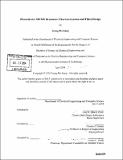Piezoelectric MEMS resonator characterization and filter design
Author(s)
Kang, Joung-Mo, 1978-
DownloadFull printable version (6.102Mb)
Alternative title
Piezoelectric microelectromechanical system resonator characterization and filter design
Other Contributors
Massachusetts Institute of Technology. Dept. of Electrical Engineering and Computer Science.
Advisor
Amy E. Duwel and Charles G. Sodini.
Terms of use
Metadata
Show full item recordAbstract
This thesis presents modeling and first measurements of a new piezoelectric MEMS resonator developed at Draper Laboratory. In addition, some simple filter designs incorporating the resonator with predicted performance parameters were analyzed, with a special focus on the suitability of using the Draper resonator to implement these filters. The four-element Butterworth Van-Dyke model, the traditional circuit model used to describe crystal resonators, was predicted to match the theoretically derived electrical behavior of the fundamental-mode resonance. A three-element "pi" network model was used to describe the overall test structure. Transformations and algorithms to convert measured s-parameter data into best-fit model parameters were developed and successfully tested on commercial thin film resonators. Measurement of the first Draper resonators was complicated by fabrication difficulties and a resulting large parasitic which only allowed low frequency longitudinal resonances to be observed. However, the observed resonances at 125.3 MHz and 148.3 MHz were found to vary with geometrical parameters as expected, providing evidence that the design is viable. Initial resonator Q was estimated to be 542. Filters were designed with estimated resonator parameters after process optimization. Three topologies, simple (coupled) ladder, dual resonator ladder, and full lattice, are described and the limits and tradeoffs among them are discussed given the Draper resonator properties. Numerical examples and an example filter-plus-resonator design process are provided. Manufacturing tolerances and their effect on resonator and filter parameters are discussed. Finally, some considerations when implementing an integrated filter bank are outlined. (cont.) The filter analyses bring to light two major goals for the next stage of resonator development. First, an accurate tuning method must be devised as the resonator bar's small size makes manufacturing errors on the order of tens of nanometers significantly affect filter characteristics. Second, a lower impedance level for the resonator is desirable to allow robust interaction with integrated RF circuitry.
Description
Thesis (M. Eng. and S.B.)--Massachusetts Institute of Technology, Dept. of Electrical Engineering and Computer Science, 2004. Includes bibliographical references (p. 98-100).
Date issued
2004Department
Massachusetts Institute of Technology. Department of Electrical Engineering and Computer SciencePublisher
Massachusetts Institute of Technology
Keywords
Electrical Engineering and Computer Science.